IAR 39
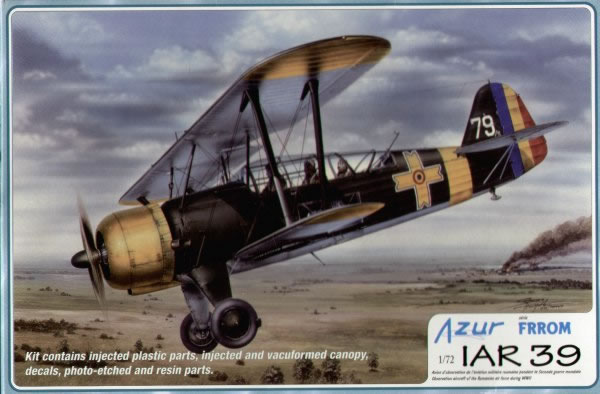
Azur Serie FRROM, 1/72 scale
S u m m a r y : |
Catalogue Number: |
Azur Serie FRROM Kit No. FR001 - IAR 39 |
Scale: |
1/72 |
Contents & Media |
43 x styrene airframe parts, 4 x clear styrene & 1 x vac-form canopy, 28 x resin parts, 1 x E fret of 28 parts, & decals 3 schemes. |
Price: |
Available on-line from Hannants for £22.97 , Model Hobbies for £25.34 and Rebel Hobby for SEK 276.00 |
Review Type: |
First Look |
Advantages: |
A well-produced kit with a choice of injected or vac-form canopies, and also injected or PE instrument panel. Nice surface detail and good decals. |
Disadvantages: |
A couple of production errors are identified in the instructions requiring some plastic trimming. The instruction regarding the distance from the fuselage for the main wing struts may be slightly incorrect. |
Conclusion: |
A generally well-produced kit with some appealing media options, and fine detail. Should build with few problems providing care is taken with the wing struts. Recommended. |
Reviewed by
Mark Davies

MPM's 1/72 scale Douglas A-20G Havoc is available online from Squadron.com
IAR 39 The IAR 39 was the third series development of an indigenous line of reconnaissance and tactical bombers, starting with the IAR 37 which first flew in 1937. The IAR 37 was introduced to replace the French Potez 25 in Romanian service. 50 were built, being powered by a licence-built Gnome-Rhone Mistral Major engine called the IAR K14-II C32 delivering 870hp. The IAR 37 was not always well liked due to being under-powered, a bit erratic in its handling, and suffering a high number of take-off and landing accidents.
The same K-14II C32 engine was being used in a licence-built version of the Savoia Marchetti SM79 which had priority over the IAR 37. An engine shortage led to a following batch of 50 being powered by 750 hp BMW 132A engines. These were known as IAR 38’s, and could be distinguished from IAR 37’s by a larger diameter cowling and two-blade wooden propeller. Presumably this even lower powered variant did little to improve on the popularity, or lack thereof, established by the IAR 39.
Further aerodynamic refinements were made, including a more streamlined cowl, and the 870 hp IAR IK-14 was re-introduced. This version was known as the AIR 39, of which 95 were built. The adoption of a more powerful 970 hp IAR K-14IV C32 engine resulted in the IAR 39A. In all just over 200 IAR 39 & 39A’s were produced by IAR and SET (the latter under producing 96 under sub-contract).
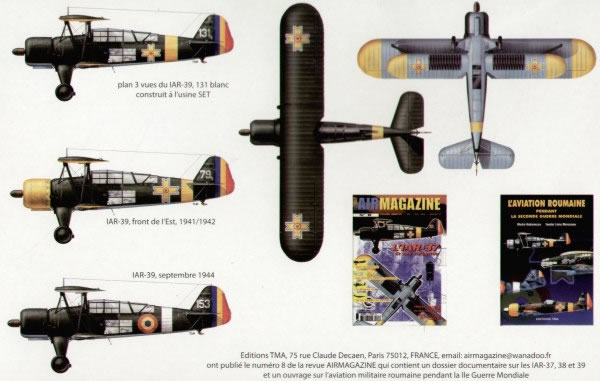
The IAR 37-39 series served throughout Romania’s involvement in WW2, equipping 15 of 18 reconnaissance squadrons. They mainly were used in the reconnaissance and army cooperation roles, as well as coastal recon and convoy escort. They were also used as light bombers in police and anti-partisan operations. A few IAR 39’s continued in service post-war for a short time.
Previous 1/72 scale IAR 39 Kits
I am only aware of one previous IAR 39 kit, this being a resin kit by Alliance, although there may well have been some others as well. Regardless, this more mainstream kit by Azur will be welcomed by enthusiasts of Yugoslavian or generally more unusual subjects.
The kit comes packed in a typically Czech end-opening box, with attractive art-work on the front and colour schemes on the rear. Azur is a French concern, but the kit is produced by the MPM/CMK-Group of the Czech Republic. The styrene parts, canopies, decals & PE fret are each enclosed in a plastic bag. The instructions are A5 format with a brief aircraft history in English, French and Romanian. The diagrammatic assembly instructions are clear and easy to follow. Detail colour call-outs are generic, but include Gunze Sangyo and another brand colour numbers (The logo for this other brand is too small and poorly printed to read). Airframe colours include RLM codes.
The parts have very fine surface detail, with the fuselage fabric areas being very subtly done. Small parts are moulded cleanly enough, but a little tidying up of parts here and there will be needed.
A nice touch I’ve noticed in other recent Azur releases is the option of injected or vac-formed canopies (you get one of each). Both are well produced and clear, although obviously the vac-form one has less optical distortion
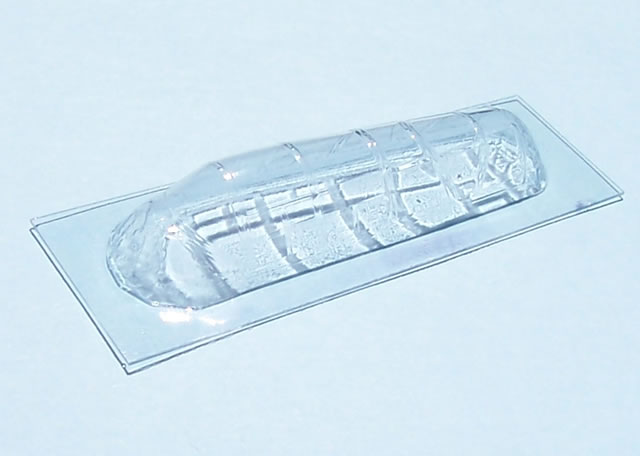
The cockpit detail is perfectly adequate for the scale with good combinations of plastic, resin and PE parts. There is a choice of styrene or PE with photo-foil instrument panel (a choice many will welcome as not everyone like PE instrument panels). Some structural framing forms a separate assembly, and it seems from the instructions that an error was made with the moulds as 1.8mm of this framing needs to be removed. The instructions also advise that some of the inside of the fuselage needs to be reduced in order for the instrument panel to fit correctly.
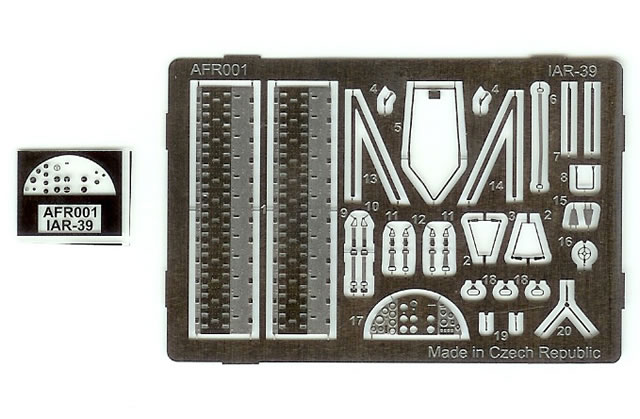
The wheels are typical of the moulding technology used in that they are solid and each split in half. I was pleased to see that the propeller blades looked better are than sometimes found with this type of limited run kit.
Construction looks to be typical for a biplane and generally straightforward. However some care will be needed with the wing struts. The wings have slightly raised oval shaped locating points for the struts. The ones on the lower wing for the main struts are presumably moulded in the wrong place as the instructions advise that these should be removed. The instructions further indicate that the struts should be located 40 mm out from the fuselage sides instead. All well and good you might say, as such things are not uncommon with limited run kits of this nature. However on researching this article I read a build review in Scale Aviation Modeller, Vol.15 Iss.4 that advises the distance should be 35 mm. The author, Chris Busbridge, considered the struts to be the right length, but in order for them to fit with the upper wing at the correct height that they should be mounted 5 mm closer inboard than the instructions suggest.
Chris Busbridge also commented that the cowling looks a bit under-sized, and having looked at photos I inclined to agree that it may be little small in diameter. However it’s a marginal call in my view, and I think I can live with the cowling as is.
There are quite a few resin parts, but most are 24 bombs that mount on PE plate-like bomb-racks. The remaining resin parts are an acceptable one-piece representation of the twin-row engine, a control column. The aircraft had two sets of controls, so presumably the observer’s column could be stowed away as it’s not supplied. Finally there are two machine guns, the dorsal one looks German MG 131 and the ventral gun like a .30 Browning.
Three colour schemes are provided in the instructions, all are dark green over blue, two being Axis machines serving on the Eastern Front with Romanian cross national insignia, and the other being from 1944 when Romania changed sides against the Germans and wears roundels.
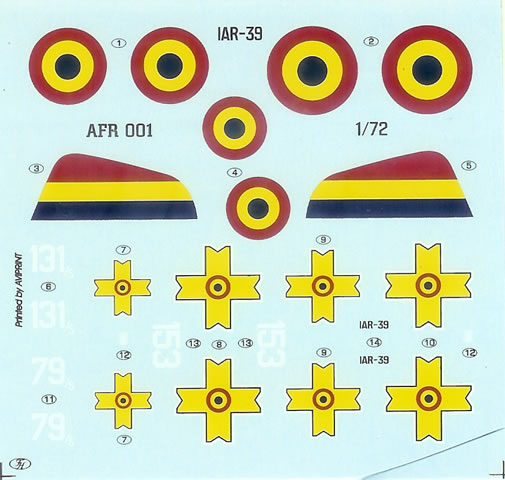
The decals themselves look excellent, with good registration and colour density. (I should explain that I accidently cut the corner off the decal sheet opening its plastic bag before scanning it for this article, thus explaining the line in the accompanying image).
This looks to be a good kit of an unusual but interesting 1940’s biplane. It’s a little let down by some post-production adjustments that are needed, but to be fair these are not unusual in this type of kit, and at least the instructions draws the builder’s attention to them. This kit should appeal to those who build small air force subjects, or who like me just find unusual subjects designs appealing.
Despite some minor criticisms I really like this subject and the kit itself; it’s one I’m looking forward to building. So well done Azur, and keep up the good work with these off-beat subjects - I admit an element of bias, but it’s still definitely recommended.
Thanks to MPM for the review sample.
Review Text and Images Copyright © 2011 by Mark Davies
Page Created 17 February, 2011
Last updated
20 February, 2011
Back to HyperScale Main Page
Back to Reviews Page

|
